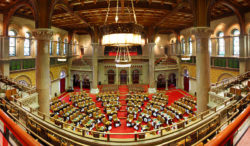
New York Assembly Chamber. Image Credit: CC-BY-SA-3.0/Matt H. Wade at Wikipedia
A proposed State bill seeks to give City broad flexibility to increase floor area ratio in residential developments. The New York Senate has introduced bill S6760 by including language in their budget resolution that will amend the State’s Multiple Dwelling Law to provide an exception for the floor area ratio (FAR) cap. Currently, the law provides for a floor area ratio not to exceed 12.0 in New York City. The amendment will introduce language to the provision that will allow exceptions to the 12.0 cap if otherwise provided under the Zoning Resolution of the City of New York.
The floor area ratio is the principal bulk regulation controlling the size of buildings. FAR is the ratio of total building floor area to the area of its zoning lot. Each zoning district has a FAR which, when multiplied by the lot area of the zoning lot, produces the maximum amount of floor area allowable on that zoning lot. For example, on a 10,000 square foot zoning lot in a district with a maximum FAR of 1.0, the floor area on the zoning lot cannot exceed 10,000 square feet.
The Multiple Dwelling Law currently reads:
Floor area ratio (FAR). The floor area ratio (FAR) of any dwelling or dwellings on a lot shall not exceed 12.0, except that a fireproof class B dwelling in which six or more passenger elevators are maintained and operated in any city having a
local zoning law, ordinance or resolution restricting districts in such city to residential use, may be erected in accordance with the provisions of such zoning law, ordinance or resolution, if such class B dwelling is erected in a district no part of which is restricted by such zoning law, ordinance or resolution to residential uses.
The amendment will add the underlined section to read:
Floor area ratio (FAR). Except as otherwise provided in the zoning resolution of the City of New York, the floor area ratio (FAR) of any dwelling or dwellings on a lot shall not exceed 12.0, except that a fireproof class B dwelling in which six or more passenger elevators are maintained and operated in any city having a local zoning law, ordinance or resolution restricting districts in such city to residential use, may be erected in accordance with the provisions of such zoning law, ordinance or resolution, if such class B dwelling is erected in a district no part of which is restricted by such zoning law, ordinance or resolution to residential uses.
Proponents of the bill state that the bill “would allow the City…through its zoning amendment procedure as specified in the City Charter, and subject to environmental review, to establish appropriate densities for the development of new or enlarged residential multiple dwellings.” According to the proponents, the City has a severe shortage of housing at all income levels and the 12.0 FAR cap is an undue constraint on the land use decision making of the city government. Proponents provide that the current procedures, such as the Uniform Land Use Review Procedure (ULURP) and the City Environmental Quality Review (CEQR), are sufficient to ensure that any adverse impact of proposed zoning changes will be duly considered and the public will have multiple opportunities to comment on any changes.
The bill looks to give the City “broad flexibility” to determine the maximum FAR allowed for residential buildings. Proponents state that the cases for where FARs will exceed the 12.0 restriction are limited by zoning regulations and other restrictions, there is existing precedent for the exception, such as the Zoning Regulation Article 7B which permits all floor area obsolete nonresidential buildings to be converted to multiple dwellings including floor area in excess of 12.0 FAR. “The extensive experience with this provision, over more than 30 years, indicates that multiple dwellings in excess of 12.0 FAR, when carefully planned, and in the right context, are appropriate and do not result in inherent land use impacts requiring a strict prohibition by state law.”
Some organizations like the Municipal Art Society of New York (MAS) have taken issue with the proposed bill. MAS states that contrary to the assertions of the bill proponents, it has identified “glaring flaws” in the zoning resolution and public review process that need to be addressed before the FAR cap is lifted. In response MAS, in what it calls its “Accidental Skyline” initiative, asks for the closing of loopholes that allow developers to skirt zoning rules and environmental regulations, that neighborhoods be given a seat at the table through local representation and increased resources, and that the City and developers accountable to the public interest.
The Regional Plan Association (RPA) is in favor of the lifting the current cap of 12.0 FAR on residential development in the City. In February 2018, RPA issued a detailed report on the merits of lifting the cap. One of RPA’s reasons for support is its belief that, absent an increase in residential density, there is no ability to require affordable housing or mixed-income buildings in the high-rise areas. “These high-rise districts desperately need more opportunities for the working- and middle-class to find affordable housing. There are three times as many residents making over $200,000/year as the city as a whole, and there has been a continual and significant decrease in affordable housing in these areas.”
Currently, the bill is in review by the Senate’s Housing Construction and Community Development Committee. The proposed bill is a Rules Bill through the Rules Committee and does not have a sponsor. A previous version was introduced in the 2015-2016 legislative session and sponsored by Senator Simcha Felder.
By: Dorichel Rodriguez (Dorichel is the CityLaw Fellow and an NYLS graduate, class of 2017.)




